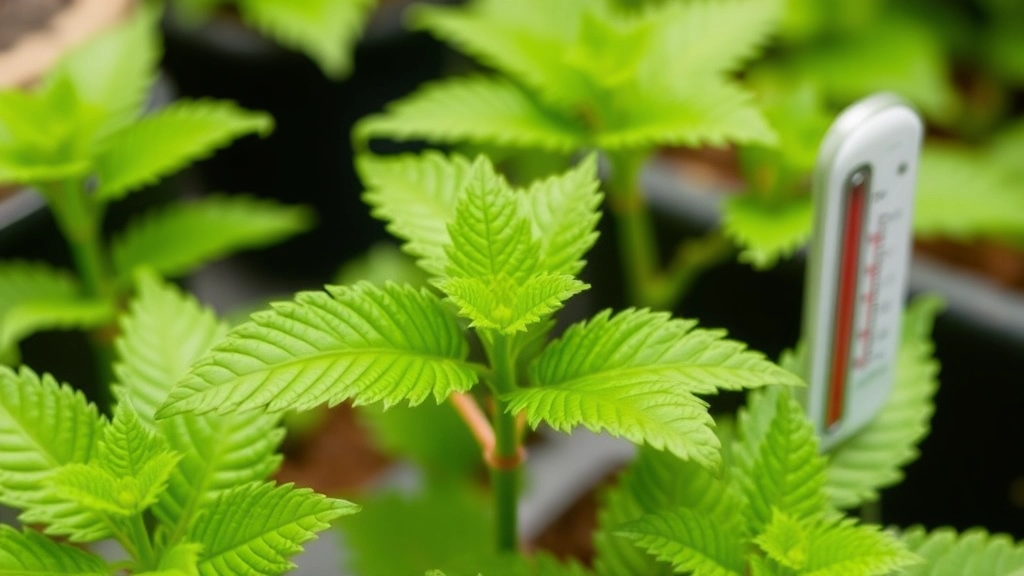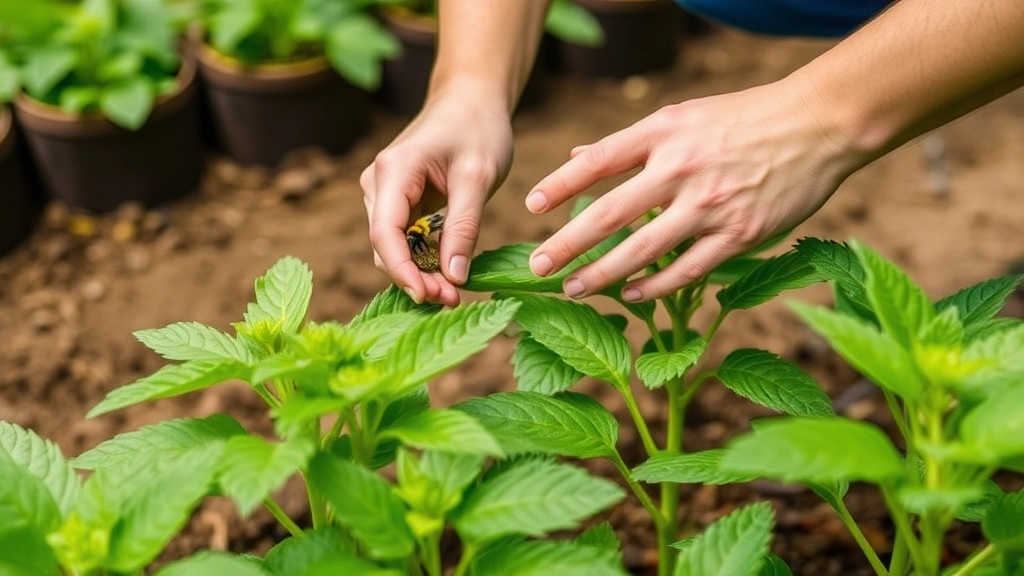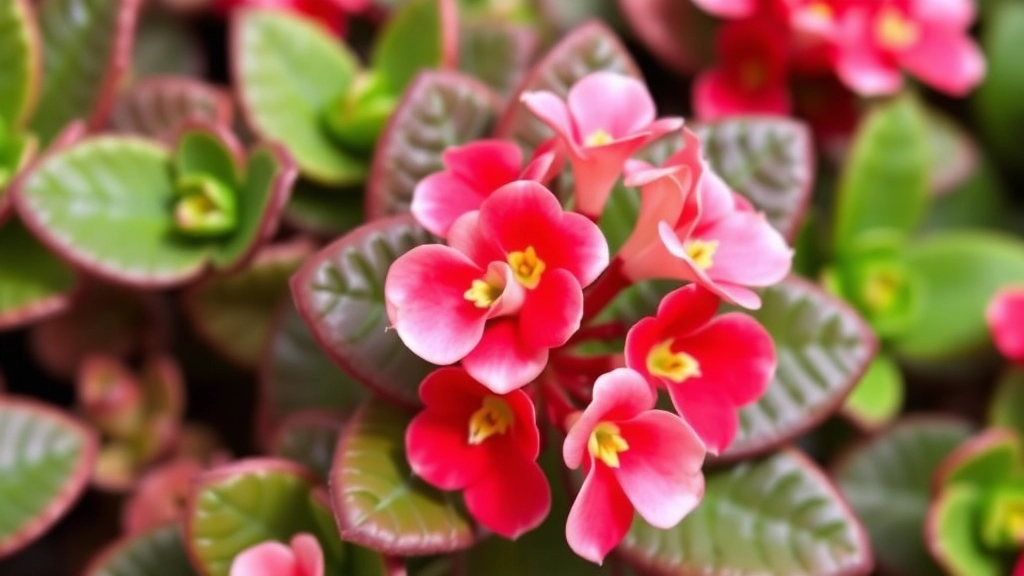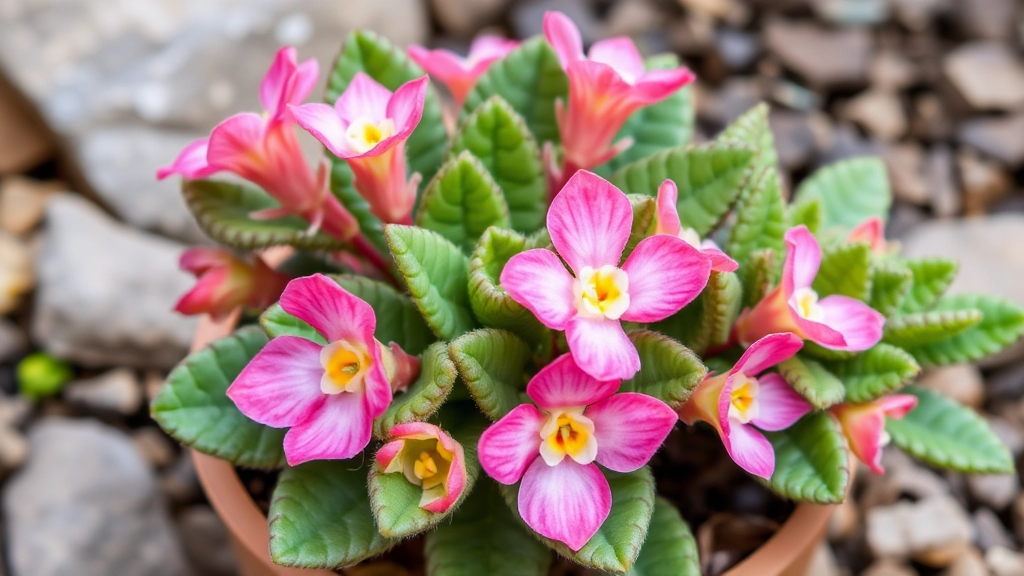Welcome to Kalanchoe Synsepala
Welcome to the world of Kalanchoe Synsepala Baker, or as it’s affectionately known, the Walking Kalanchoe. If you’re keen on understanding this unique plant, you’ve come to the right place. This article will delve into its physical characteristics, ideal growing conditions, and much more, ensuring you have all the knowledge needed to care for your Kalanchoe Synsepala.
Physical Characteristics
Let’s start with the basics: the physical characteristics of Kalanchoe Synsepala. This succulent boasts thick, fleshy leaves that are typically green with a hint of red along the edges. Its most intriguing feature is its ability to produce new plantlets along its leaf margins, giving it the nickname “Walking Kalanchoe.” These plantlets eventually drop off and root, creating a new generation of plants.
Physical Characteristics of Kalanchoe Synsepala
Are you curious about what makes Kalanchoe synsepala stand out among other succulent plants? Understanding its physical characteristics can help you appreciate its unique beauty and care needs.
Kalanchoe synsepala, commonly known as Walking Kalanchoe, is a striking succulent that boasts several distinctive features:
- Leaves: The leaves are fleshy, elongated, and can grow up to 10 cm long. They are often a vibrant green, sometimes displaying a subtle reddish hue, especially when exposed to bright light.
- Growth Habit: This plant has a unique growth pattern. It can develop a sprawling habit, with stems that may reach up to 30 cm in length. The stems can root where they touch the soil, allowing the plant to spread and create a lush ground cover.
- Flowers: In the right conditions, Kalanchoe synsepala produces clusters of small, tubular flowers. These blooms are typically bright orange or red and can add a splash of colour to your garden or indoor space.
- Bulbils: One of the most fascinating aspects of this plant is its ability to produce bulbilsâsmall plantlets that form along the edges of the leaves. These can easily root and grow into new plants, making propagation straightforward.
If you’re interested in learning more about different varieties, check out our Kalanchoe Succulent Identification Guide. For detailed care instructions, refer to our Ultimate Guide on Caring for Kalanchoe Succulents.
Ideal Growing Conditions and Temperature Requirements

So, you’re keen on nurturing your Kalanchoe Synsepala, right?
You might be wondering, “What’s the best environment for my Walking Kalanchoe?”
Well, let’s dive into that!
Light Requirements
Kalanchoe Synsepala thrives in bright, indirect sunlight.
- Ideal Spot: A south-facing window is perfect.
- Too Much Sun: Direct sunlight can scorch those lovely leaves.
Temperature Preferences
When it comes to temperature, these plants are quite particular.
- Optimal Range: They prefer temperatures between 20°C to 25°C during the day.
- Nighttime Chill: At night, they can handle a slight drop to around 15°C.
Humidity Levels
Kalanchoe Synsepala isn’t a fan of high humidity.
- Low Humidity: Aim for around 30-50%.
- Dry Air: They can tolerate dry conditions, making them great for indoor environments.
Soil Type
Now, let’s talk about soil.
- Well-Draining Mix: Use a cactus or succulent mix.
- pH Level: A slightly acidic to neutral pH is ideal.
Air Circulation
Good air circulation is a must.
- Avoid Stagnation: This helps prevent fungal issues.
- Open Spaces: Keep your plant in a spot with good airflow.
Watering and Humidity Management for Walking Kalanchoe
When it comes to caring for your Kalanchoe Synsepala, watering and humidity management are crucial factors that can significantly influence its health and growth.
Watering Guidelines
Many plant enthusiasts often wonder, “How much water does my Walking Kalanchoe really need?”
- Soil Type: Ensure you use well-draining soil to prevent waterlogging.
- Watering Frequency: Water your Kalanchoe when the top inch of soil feels dry. Generally, this means watering every 1-2 weeks, depending on the season.
- Signs of Overwatering: Yellowing leaves or a mushy stem can indicate too much water. Adjust your watering schedule accordingly.
- Signs of Underwatering: If the leaves wrinkle or the plant appears droopy, it may be thirsty.
Humidity Management
Kalanchoe Synsepala thrives in moderate humidity levels. You might ask, “How do I maintain the right humidity for my plant?”
- Ideal Humidity Levels: Aim for humidity levels between 40-60%.
- Methods to Increase Humidity:
- Place a humidity tray filled with water and pebbles near the plant.
- Group your Kalanchoe with other plants to create a microclimate.
- Avoid Excessive Humidity: High humidity can lead to fungal issues. Ensure good air circulation around your plant.
By mastering the balance of watering and humidity, you can create a thriving environment for your Walking Kalanchoe. For more detailed care tips, check out our Kalanchoe Paddle Plant Care Guide and discover the Flowering Period Care Tips for Kalanchoe Blossfeldiana.
Fertilization Techniques for Optimal Growth

As we delve into fertilization techniques, it’s essential to understand how proper nutrition can significantly enhance the growth of Kalanchoe Synsepala.
Many plant enthusiasts often wonder, “How can I ensure my Walking Kalanchoe thrives?” The answer lies in balanced and timely fertilization.
Types of Fertilizers
- Liquid Fertilizers:
- Use a balanced liquid fertilizer diluted to half strength.
- Apply every 4-6 weeks during the growing season (spring and summer).
- Granular Fertilizers:
- Opt for a slow-release granular fertilizer.
- Apply according to package instructions at the beginning of the growing season.
- Organic Options:
- Consider compost or well-rotted manure.
- These not only provide nutrients but also improve soil structure.
Key Nutrients to Focus On
- Nitrogen (N): Promotes lush, green foliage.
- Phosphorus (P): Encourages strong root development and flowering.
- Potassium (K): Aids in overall plant health and resilience.
Timing and Frequency
- Begin fertilizing in early spring as the plant wakes from dormancy.
- Reduce or stop fertilization in late autumn when growth slows.
Signs of Nutrient Deficiency
- Yellowing leaves may indicate a lack of nitrogen.
- Poor flowering could suggest insufficient phosphorus.
Are you wondering how to expand your collection of Kalanchoe Synsepala?
This resilient succulent offers several propagation methods that are both straightforward and rewarding.
One of the most fascinating aspects of Kalanchoe Synsepala is its ability to produce bulbilsâsmall plantlets that grow along the edges of mature leaves.
Here’s how to propagate using bulbils:
– **Identify Healthy Bulbils:** Look for bulbils that are well-formed and have roots.
– **Remove Carefully:** Gently twist or cut the bulbil from the leaf without damaging the parent plant.
– **Allow to Callous:** Let the bulbil dry for a day or two to prevent rot.
– **Plant in Soil:** Place the bulbil in well-draining soil, burying it slightly.
– **Water Sparingly:** Mist the soil lightly, ensuring it remains moist but not soggy.
This method is not only effective but also a delightful way to witness the growth cycle of your plant. For more detailed tips, you can check out this [complete guide to growing Kalanchoe Mother of Thousands](https://planthq.org/complete-guide-to-growing-kalanchoe-mother-of-thousands/).
If bulbils aren’t available, leaf cuttings are another reliable propagation method.
Follow these steps for successful leaf cutting propagation:
– **Select a Healthy Leaf:** Choose a plump, healthy leaf from the parent plant.
– **Cut the Leaf:** Use a clean, sharp knife to slice the leaf at the base.
– **Let it Callous:** Allow the cut end to dry for a few days.
– **Plant in Soil:** Insert the calloused end into well-draining soil.
– **Maintain Moisture:** Lightly water the soil and cover the pot with a plastic bag to retain humidity.
Both methods are effective, but bulbils can provide quicker results due to their pre-formed roots. If you’re interested in more propagation techniques, consider exploring our [ultimate guide to growing Kalanchoe Pink Plant](https://planthq.org/ultimate-guide-to-growing-kalanchoe-pink-plant/).
Common Problems and Solutions in Growing Kalanchoe Synsepala

So, you’ve got your Kalanchoe Synsepala thriving, but then you notice something off.
What do you do?
Let’s dive into some common issues and how to tackle them.
1. Overwatering Woes
One of the biggest mistakes new Kalanchoe owners make is overwatering.
Signs: Yellowing leaves or mushy stems.
Solution:
- Always check the soil first.
- If it feels wet, hold off on watering for a while.
- Make sure your pot has drainage holes.
2. Pests and Infestations
Pests can sneak up on you.
Common culprits: Mealybugs and aphids.
Signs: Sticky residue on leaves or visible bugs.
Solution:
- Wipe leaves with a damp cloth.
- Use insecticidal soap if the problem persists.
3. Leaf Drop
If your leaves are dropping like it’s autumn, something’s off.
Causes: Sudden temperature changes or stress from repotting.
Solution:
- Keep your plant in a stable environment.
- Avoid moving it around too much.
4. Lack of Blooms
You want those blooms, but they just won’t show up.
Causes: Insufficient light or improper fertilization.
Solution:
- Ensure it gets bright, indirect sunlight.
- Feed it with a balanced fertilizer during the growing season.
5. Fungal Issues
Fungi can be sneaky, especially in humid conditions.
Signs: Dark spots on leaves or a fuzzy appearance.
Solution:
- Allow for better airflow around the plant.
- Remove affected leaves and avoid overhead watering.
6. Leaf Discoloration
If your leaves are turning brown or crispy, it’s a cry for help.
Causes: Too much direct sunlight or underwatering.
Solution:
- Move it to a spot with filtered light.
- Check your watering schedule to ensure it’s getting enough moisture.
As we transition into seasonal changes, it’s essential to consider how these shifts impact the care of Kalanchoe Synsepala.
### Understanding Dormancy
During the colder months, Kalanchoe Synsepala enters a state of dormancy. This is a natural process where the plant conserves energy and reduces its growth rate.
### Key Seasonal Care Tips:
– **Light Exposure:**
– In winter, ensure your plant receives adequate light.
– A south-facing window is ideal, as it provides maximum sunlight.
– **Watering Schedule:**
– Cut back on watering during dormancy.
– Water only when the top inch of soil feels dry to the touch.
– **Temperature Management:**
– Keep your Kalanchoe in a room with temperatures between 10°C and 15°C during dormancy.
– Avoid placing it near drafts or heating vents.
– **Fertilization Pause:**
– Hold off on fertilising during the winter months.
– Resume feeding in spring when new growth appears.
### Spring Awakening
As spring arrives, Kalanchoe Synsepala will begin to show signs of life.
– **Reintroduce Watering:**
– Gradually increase your watering frequency as the plant starts to grow.
– **Fertilisation Resumption:**
– Start using a diluted, balanced fertiliser to encourage healthy growth.
– **Repotting Opportunity:**
– Consider repotting if you notice roots emerging from the drainage holes.
For more comprehensive tips on caring for various Kalanchoe species, you might find our [Kalanchoe Succulent Identification Guide](https://planthq.org/kalanchoe-succulent-identification-guide-top-varieties-traits/) insightful. Additionally, if you’re interested in specific care tips for another variety, check out our guide on [How to Care for a Kalanchoe Succulent](https://planthq.org/how-to-care-for-a-kalanchoe-succulent-expert-tips/).
FAQs about Kalanchoe Synsepala Baker
What are the light requirements for Kalanchoe Synsepala?
Kalanchoe Synsepala thrives in bright, indirect sunlight. A south-facing window is ideal, but be cautious of direct sunlight as it can scorch the leaves.
What is the optimal temperature range for Kalanchoe Synsepala?
These plants prefer temperatures between 20°C to 25°C during the day and can handle a slight drop to around 15°C at night.
How much humidity does Kalanchoe Synsepala need?
Kalanchoe Synsepala prefers low humidity levels, ideally around 30-50%. It can tolerate dry conditions, making it suitable for indoor environments.
What type of soil is best for Kalanchoe Synsepala?
A well-draining mix, such as a cactus or succulent soil, is ideal. The soil should have a slightly acidic to neutral pH.
How important is air circulation for Kalanchoe Synsepala?
Good air circulation is crucial to prevent fungal issues. Place your plant in a spot with good airflow to avoid stagnation.
What types of fertilizers should I use for Kalanchoe Synsepala?
You can use liquid fertilizers diluted to half strength, slow-release granular fertilizers, or organic options like compost or well-rotted manure. Apply these during the growing season (spring and summer).
What nutrients are important for Kalanchoe Synsepala?
Focus on providing Nitrogen (N) for lush foliage, Phosphorus (P) for strong root development and flowering, and Potassium (K) for overall plant health and resilience.
When should I start and stop fertilizing Kalanchoe Synsepala?
Begin fertilizing in early spring as the plant wakes from dormancy and reduce or stop fertilization in late autumn when growth slows.
What are common signs of nutrient deficiency in Kalanchoe Synsepala?
Yellowing leaves may indicate a lack of nitrogen, while poor flowering could suggest insufficient phosphorus.
How can I prevent overwatering my Kalanchoe Synsepala?
Always check the soil before watering. If it feels wet, hold off on watering. Ensure your pot has drainage holes to prevent water accumulation.
What should I do if my Kalanchoe Synsepala has pests?
Common pests include mealybugs and aphids. Wipe the leaves with a damp cloth and use insecticidal soap if the problem persists.
Why are the leaves of my Kalanchoe Synsepala dropping?
Leaf drop can be caused by sudden temperature changes or stress from repotting. Keep your plant in a stable environment and avoid moving it around too much.
Why is my Kalanchoe Synsepala not blooming?
Insufficient light or improper fertilization can prevent blooming. Ensure your plant gets bright, indirect sunlight and feed it with a balanced fertilizer during the growing season.
How can I address fungal issues in my Kalanchoe Synsepala?
Allow for better airflow around the plant, remove affected leaves, and avoid overhead watering to prevent fungal issues.
What should I do if the leaves of my Kalanchoe Synsepala are turning brown or crispy?
This can be a sign of too much direct sunlight or underwatering. Move the plant to a spot with filtered light and check your watering schedule to ensure it’s getting enough moisture.
References
-
How to Grow Kalanchoe – Gardener’s World
-
Kalanchoe Succulent Varieties – The Spruce
-
Kalanchoe Care Guide – Houseplants Expert
